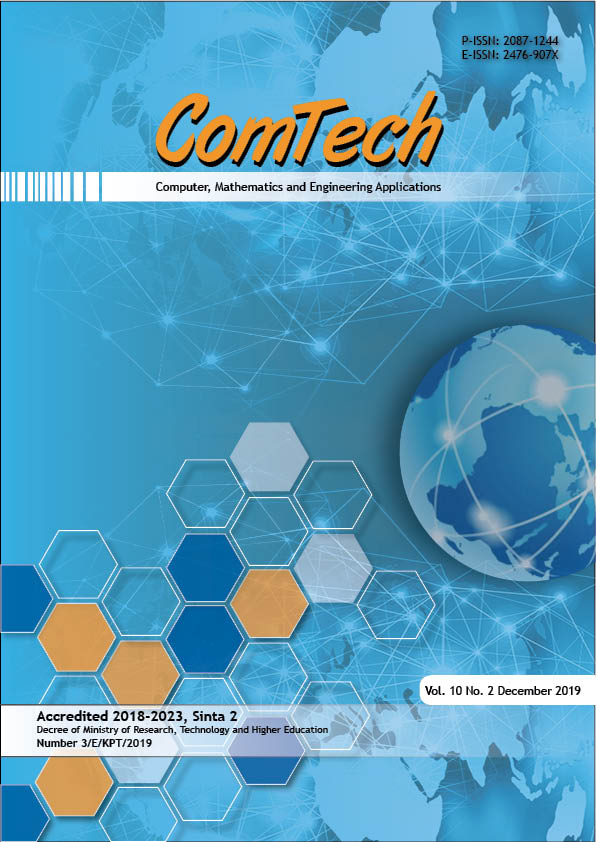The Development of Furniture Assembly Instruction Based on Augmented-Reality
DOI:
https://doi.org/10.21512/comtech.v10i2.5853Keywords:
Augmented Reality, furniture assembly instructionAbstract
This research utilized Augmented Reality (AR) technology along with interactive multimedia applications to improve visual guidance and assist nonexpert users in assembling furniture. Rather than paperbased or video instructions, AR enhanced learning and manipulative-interactive approach. This research used the Waterfall model for development. It was divided into a couple of stages. It consisted of specifying the problem and requirements, designing the system, implementing and integrating it, and testing the system. Identifying problems and requirements was conducted through an online questionnaire and related works study. The graphics tool used was 3D Studio Max. Unity3d was used to develop the system with the software library from Qualcomm’s Vuforia for the AR implementation. The results show the mobile application called ARsembly. It serves as the early stage of concept model as it only assists the simple assembly. Through system testing performed by both researchers and end-users, ARsembly is proven to be useful and helpful in learning and performing furniture assembly.
References
Bacca, J., Baldiris, S., Fabregat, R., Graf, S., & Kinshuk. (2014). Augmented reality trends in education: A systematic review of research and applications. Educational Technology & Society, 17(4), 133-149.
Bird, D. K. (2009). The use of questionnaires for acquiring information on public perception of natural hazards and risk mitigation–a review of current knowledge and practice. Natural Hazards and Earth System Sciences, 9(4), 1307-1325.
Holst, A. (2019a). Market share of mobile operating systems worldwide 2012-2019. Retrieved from https://www.statista.com/statistics/272698/global-market-share-held-by-mobile-operating-systems-since-2009/
Holst, A. (2019b). Smartphone users worldwide 2016-2021. Retrieved from https://www.statista.com/statistics/330695/number-of-smartphone-users-worldwide/
Grubert, J., & Grasset, R. (2013). Augmented reality for Android application development. Birmingham, UK: Packt Publishing Ltd.
Mayer, R. E. (2014). Incorporating motivation into multimedia learning. Learning and Instruction, 29(February), 171-173.
Siltanen, S., Lokki, T., Tervo, S., & Savioja, L. (2012). Modeling incoherent reflections from rough room surfaces with image sources. The Journal of the Acoustical Society of America, 131(6), 4606-4614.
Sommerville, I. (2011). Software engineering (9th ed.). Massachusetts: Pearson Education.
Statista Research Department. (2019). Share of mobile operating systems in Indonesia 2012-2019, by OS. Retrieved from https://www.statista.com/statistics/262205/market-share-held-by-mobile-operating-systems-in-indonesia/
Syberfeldt, A., Danielsson, O., Holm, M., & Wang, L. (2015). Visual assembling guidance using augmented reality. Procedia Manufacturing, 1, 98-109.
Tiefenbacher, P., Lehment, N. H., & Rigoll, G. (2014). Augmented reality evaluation: A concept utilizing virtual reality. In International Conference on Virtual, Augmented and Mixed Reality (pp. 226-236).
Van Krevelen, D. W. F., & Poelman, R. (2010). A survey of augmented reality technologies, applications and limitations. The International Journal of Virtual Reality, 9(2), 1-20
Yesmaya, V., Dekapaswan, J., Aspurua, K., & Prasetyo, I. (2019). Perancangan aplikasi Ensiklopedia menggunakan augmented reality berbasis Android. Jurnal Telematika, 13(1), 27-32.
Downloads
Published
How to Cite
Issue
Section
License
Authors who publish with this journal agree to the following terms:
a. Authors retain copyright and grant the journal right of first publication with the work simultaneously licensed under a Creative Commons Attribution License - Share Alike that allows others to share the work with an acknowledgment of the work's authorship and initial publication in this journal.
b. Authors are able to enter into separate, additional contractual arrangements for the non-exclusive distribution of the journal's published version of the work (e.g., post it to an institutional repository or publish it in a book), with an acknowledgment of its initial publication in this journal.
c. Authors are permitted and encouraged to post their work online (e.g., in institutional repositories or on their website) prior to and during the submission process, as it can lead to productive exchanges, as well as earlier and greater citation of published work.
 USER RIGHTS
 All articles published Open Access will be immediately and permanently free for everyone to read and download. We are continuously working with our author communities to select the best choice of license options, currently being defined for this journal as follows:




















